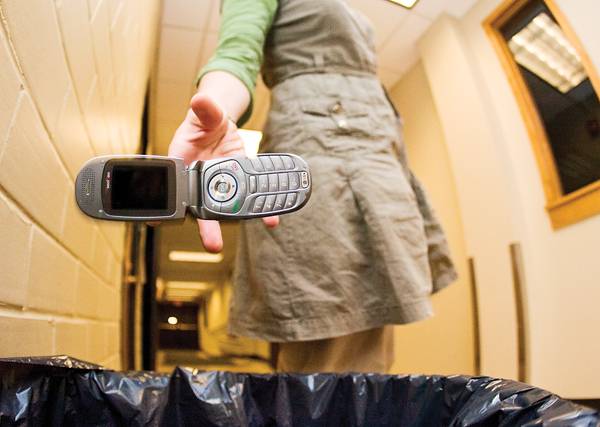Used and broken phones can find a new home through recycling program

Though it is legal to throw away cell phones in Iowa, it is strongly discouraged due to the many toxic chemicals that could pollute landfills. Iowa State offers five different locations around campus where students can drop off their cell phones to recycle them. Photo Illustration: Manfred Strait/Iowa State Daily
November 23, 2008
Old cell phones, whether they work or not, can be left in a much better place than the trash bin when students are done with them.
The phones can be dropped off at five different locations on campus, where they will be disposed of in an environmentally conscious way.
Roy Bingham, environmental specialist in the department of environmental health and safety, said the campus drop-offs for old cell phones and rechargeable batteries are not being used as much as the department would like to see.
“The rechargeable batteries within the cell phones are regulated materials, so they should not go into the landfill, because we don’t want to pollute the landfill,” Bingham said.
Sean Whalen, environmental specialist in the department, said cell phones have toxic chemicals in them.
“Cell phones, like other electronics, may contain a variety of toxic components, such as lead, nickel, silver and cadmium,” Whalen said. “Fortunately, like all electronics, they are 100 percent recyclable.”
According to www.recyclemycellphone.org, a cell phone recycling organization, more than 500 million used cell phones are estimated to be in U.S. landfills or sitting on shelves unused. An estimated 130 million phones will be added to that number this year.
The toxic materials in cell phones can pollute the air if incinerated, and in landfills they can pollute the groundwater, according to the Web site.
The Rechargeable Battery Recycling Corporation is a non-profit corporation that provides cell phone and battery recycling boxes to Iowa State and other public entities, Whalen said. The corporation’s Web site indicates that it also provides recycling boxes to retailers around the country.
According to a document available on its Web site, rechargeable batteries from other electronic objects can be recycled through recycling boxes like those on campus. Other objects containing rechargeable batteries include power tools, laptop computers, digital cameras, camcorders and remote control toys.
Cell phones owned by Iowa State — purchased for use by staff, faculty and students — must be recycled due to their nature as potentially hazardous waste, Whalen said.
Cell phones owned by individuals, he said, may legally be thrown in the garbage in Iowa, but recycling is strongly encouraged.
Bingham said if a phone dropped off in Iowa State’s receptacles is fully functioning, it may be given to a local facility, such as a domestic violence or youth shelter.
“If the phone is in good enough shape, they can recycle it that way,” Bingham said. “It’s getting re-used.”
Otherwise, cell phones are broken down into individual components, and everything, including the batteries, is recycled by Iowa State.
Bingham said he is aware of no incentives in place for student cell-phone recycling.
Engineering professor has a history of improving cell phones’ environmental safety
Iver Anderson, adjunct professor of materials science and engineering, has helped reduce the dangers of electronic waste by focusing on one potentially dangerous component: lead. More specifically, Anderson has focused on eliminating leaded solder.
Anderson’s work with lead-free solder goes back to 1992, he said. In the past, it was more common for solder, an important component in electronic objects, to contain lead.
“If you take your cell phone apart, there are electronic circuits there that are bonded onto a flexible sheet, which is backing for all these components. All these components are joined to that sheet with lead-free solder,” Anderson said. “Previously, that had been leaded solder.”
Lead, Anderson said, is one of the easiest of all the possible harmful substances to leach into groundwater.
Anderson and his colleagues were able to develop a lead-free alloy to take the place of leaded solder in 1993, he said. In 1996, the patent was issued, and it has eventually become a common material used in the electronic industry.
“Humans have had about 5,000 years of experience with tin lead, so it’s a huge undertaking to replace such a material,” Anderson said.
Where to recycle on campus
Boxes with the word “RECYCLE” printed on them are located at five locations on campus. Students can leave their phones in any of the boxes at the following locations:
Durham Center, room 74
Science II, room 339
Central Stores, 195 General Services Building
Chemistry Stores, 1351 Gilman Hall
Environmental Health and Safety Services Building, 2809 Daley Drive






